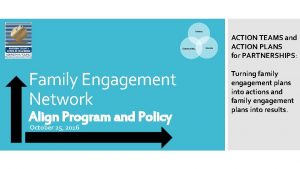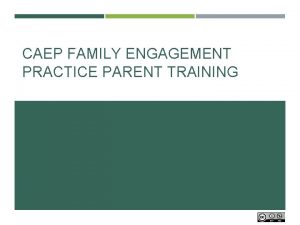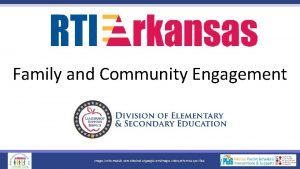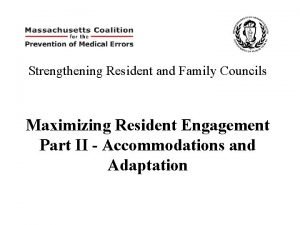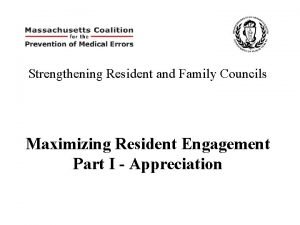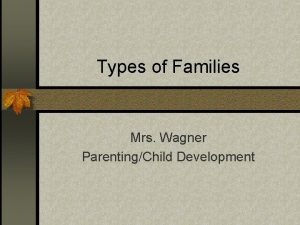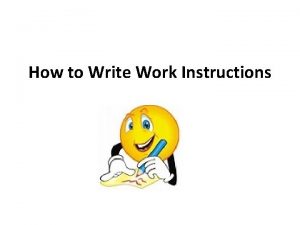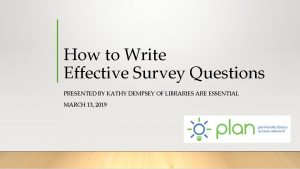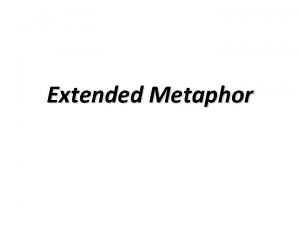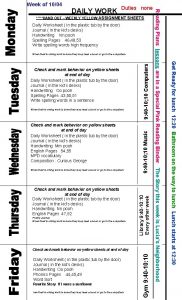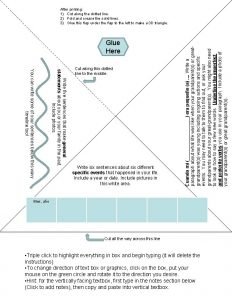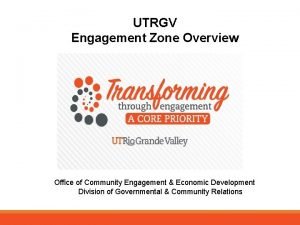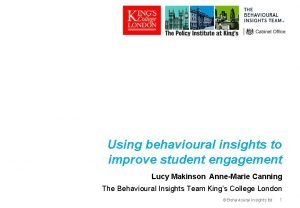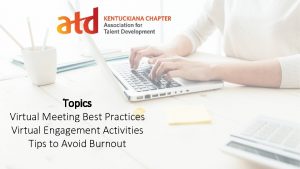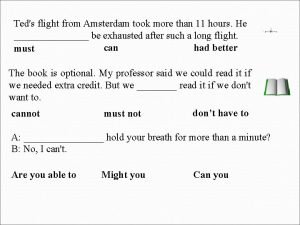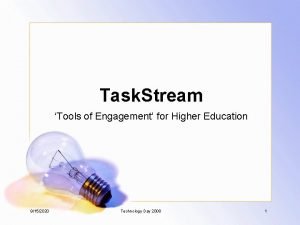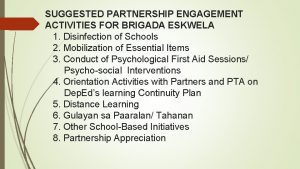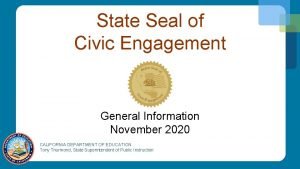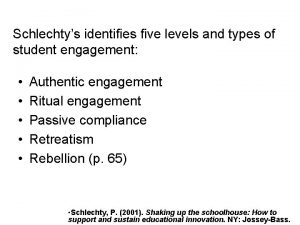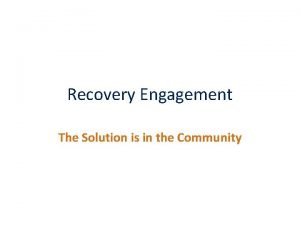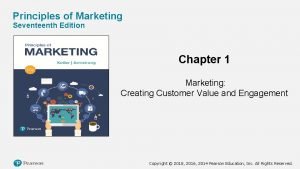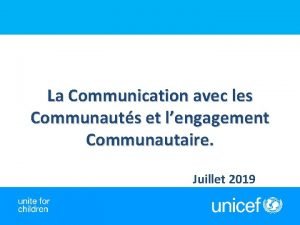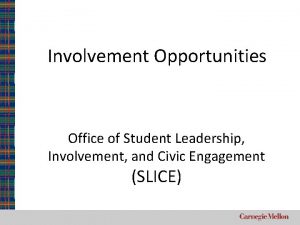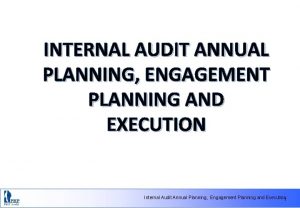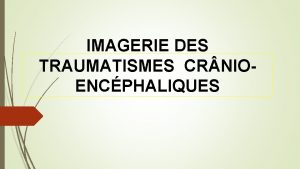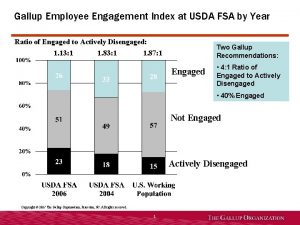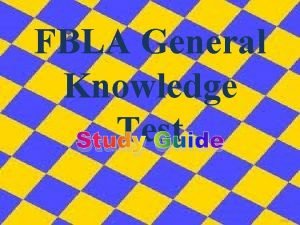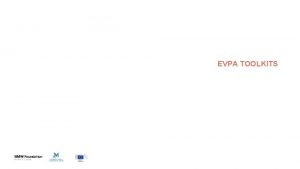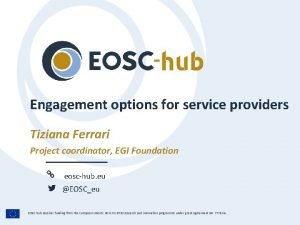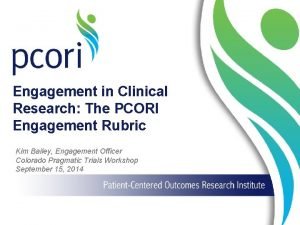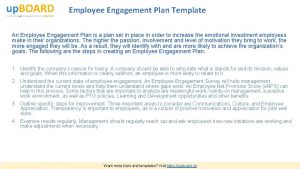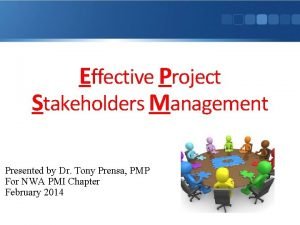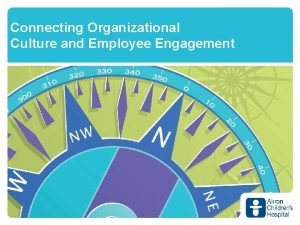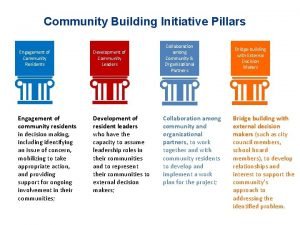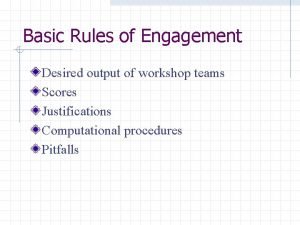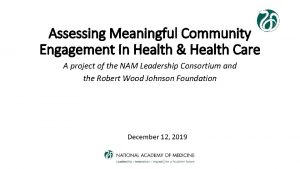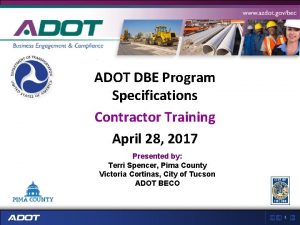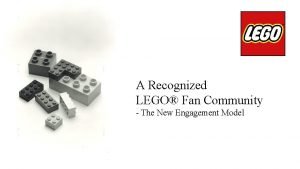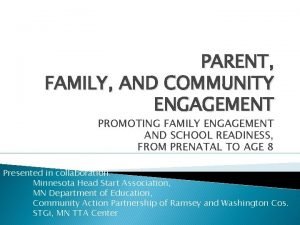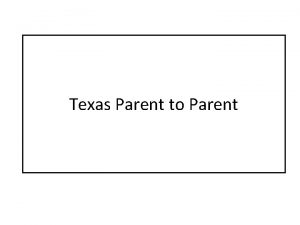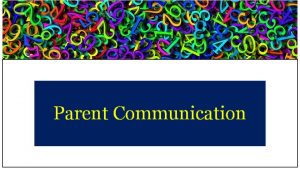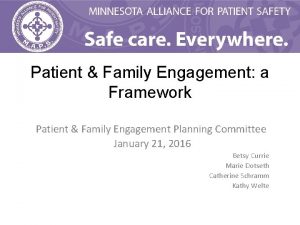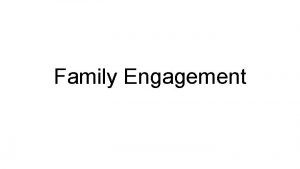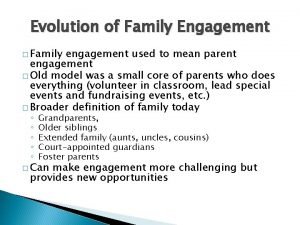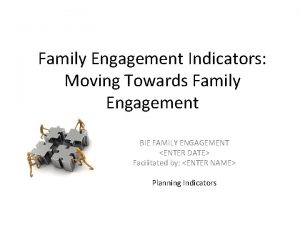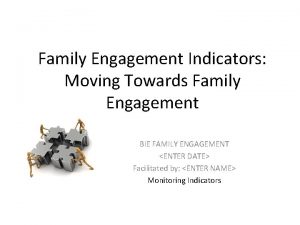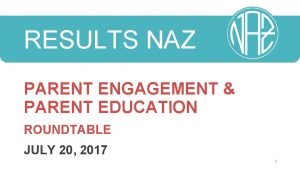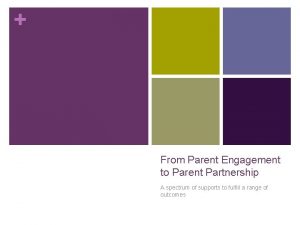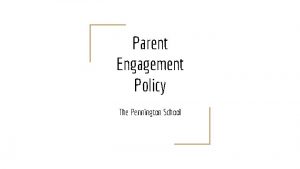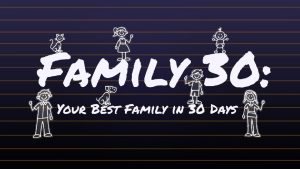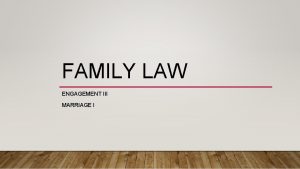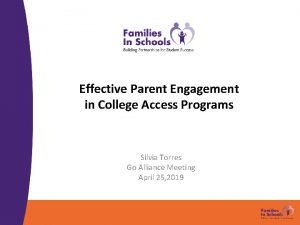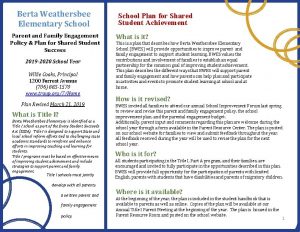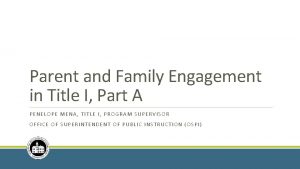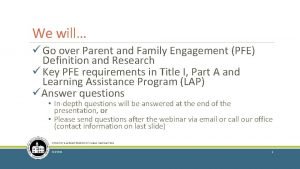HOW TO WRITE AN EFFECTIVE PARENT FAMILY ENGAGEMENT























































- Slides: 55

HOW TO WRITE AN EFFECTIVE PARENT & FAMILY ENGAGEMENT PLAN (PFEP) TITLE I DESIGNEE TRAINING


Agenda ESSA PFEP (Parent & Family Engagement Plan) I. Involvement of Families II. Flexible Parent Meetings III. Communication IV. Annual Parent Meeting V. Barriers VI. Building Capacity VII. Coordination and Integration with other Federal Programs PFEP Budget Break Digital Compliance

Every Student Succeeds Act (ESSA)



Parent & Family Engagement


Ice Breaker What factors should one consider when planning to engage families to support student learning?

Involvement of parents How will you involve the parents and families in an organized, ongoing and timely manner, planning, review and improvement of Title I programs, including involvement in decision m how funds for Title I will be used? BUILD ON FAMILIES’ STRENGTHS v Acknowledge the family wants to help their children succeed v Ask family how they want to be involved v Create opportunities for families to be involved, based on their strengths, skills, knowled v Families & schools work together as partners in setting goals for children’s education

Flexible Parent Meetings Ø How will the school offer a flexible number of meetings, such as meetings in the morning or evening? Ø How will the school provide, with Title I funds, transportation, child care or home visits, as such services relate to parent and family engagement?

Communication Ø How the school will provide timely information about the Title I programs? 1. Flyer must be sent out at least two weeks prior to event Ø How the school will describe and explain the curriculum at the school, the forms of assessment used to measure student progress and the achievement levels students are expected to obtain? I. Note you can have more than one assessment night Ø How, if requested by parents, the school provides opportunities for regular meetings to formulate suggestions and to participate, as appropriate, in decisions relating to the education of their child(ren)? I. Parent/Teacher conferencs II. Suggestion Box III. Parent Liaison Ø How the school will submit parents/families comments if the schoolwide plan is not satisfactory to them?

Annual Parent Meeting Ø A description of the specific steps the school will take to conduct the annual meeting to inform parents and families of participating children about the school’s Title I program? Ø A description of the nature of the Title I program that is shared with parents (schoolwide or targeted assistance)? Ø A description of how the meeting will cover adequate yearly progress (AYP), school choice, and the rights of parents are covered at the annual meeting?


Barriers Ø A description of the barriers that hindered participation by parents during the previous school year? Ø A description of the steps the school will take during the upcoming school year to overcome the barriers (with particular attention paid to parents/families who are disabled, have limited English proficiency, and parents/families of migratory children)?

Building Capacity Ø How the school will implement activities that will build the capacity for meaningful parent/family involvement event? Ø How will the school implement activities that will build relationships with the community to improve student achievement? I. Not all events will be payable through Title I, however it is important to build a healthy relationship with your parents.

Ø How will the school implement activities that will build relationships with the community to improve student achievement? I. Faith Based Community II. Community organizations III. Colleges Ø How the school will provide materials and trainings to assist parents/families to work with their child(ren)? I. Make and Takes II. Homework assistance for parents III. Websites IV. Parent Resource Rooms Ø How the school will provide other reasonable support for parent/family engagement activities?

Coordination and Integration Ø How the school will coordinate and integrate parent and family engagement programs and activities with other Federal Programs? I. ESE II. ESOL III. Homeless Ø How the school will coordinate and integrate parent and family activities that teach parents how to help their child(ren) at home? I. Parent Academy II. Parent trainings


PFEP BUDGET











Digital compliance

AIA-1 Notification to stakeholders of the annual School Public Accountability Reports AIA-1. 1. 0 (SPARs) with dates of dissemination. (FSA Report) AIA-1. 2. 0 Evidence of End of Year student performance and scores on state exams. (Ex. EOC, i. Ready, FSA, PERT, FCAT) AIA-1. 2. 1 Progress Reports (one per quarter) AIA-1. 2. 2 Report Cards (one per quarter) AIA-1. 2. 3 Other evidence as desired (i. Reade, Achieve, EOC Exams, Pert ect. )

AIA-2. 1. 0 Dated meeting agendas, sign-in sheets, and notes pertaining to the review of academic assessments and non-academic indicators to evaluate student and school progress to improve the school program. AIA-2. 1. 1 Meeting agendas, minutes and sign in sheets from faculty meetings, collaborative planning or PLCs regarding student assessment. AIA-2. 1. 2 Meeting agendas, minutes and sign in sheets from SAC meetings regarding student assessment. (Min of 8 meetings) AIA-2. 1. 3 Meeting agendas, minutes and sign in sheets from School leadership meetings regarding student assessment. AIA-2. 2. 0 Sample(s) of focus calendars that demonstrates that classroom instruction meets the needs of low-achieving students.

AIA-2. 2. 1 Sample(s) of lesson plans that demonstrates that classroom instruction meets the needs of low-achieving students. AIA-2. 2. 2 Sample(s) of RTI plans, or other evidence, as applicable, that demonstrates that classroom instruction meets the needs of low-achieving students Evidence that assessment data was used to identify students at risk of reading failure. (What assessment was used to identify such students) Evidence that the instructional program was changed to meet the specific needs of students AIA-2. 4. 0 (Reading Interventionist schedule, or any other pull out or push in schedule with the identified students) AIA-2. 3. 0

AIA-2 AIA-3. 1. 0 A copy of the school Comprehensive Needs Assessment Process. This could be a copy of your SIP AIA-3. 2. 0 Evidence that the needs of migratory students are included in the CNA

AIA-4. 1. 0 A sample of schoolwide plans (SIP) that include the ten (10) required elements (SIP) Evidence of the development of the schoolwide plan (e. g. , meeting minutes showing AIA-4. 2. 0 teacher, parent, and community input, etc. ) (SIP Developmental Meeting) Evidence of input from parents for the SIP and if input was provided, how that input was addressed and used (include all SAC meeting minutes with minutes showing the AIA-4. 3. 0 SIP was discussed) (SAC meeting where the SIP was discussed)

AIA-7 School Professional Development Plan AIA-7. 1. 0 (School Wide Professional Development Plan, can be found it SIP is one is not done separately) A sample of budget/expenditure reports for professional development in Title I AIA-7. 2. 0 schools. (Title I Part A School Wide Budget) Documentation of professional development provided in relation to the needs assessment, reform strategies, and instructional programs/practices (e. g. , list/calendar of professional development offered, list of participants, etc. ) AIA-7. 3. 0 Include sign in sheets from each early release session, each PLC, each common planning session. (Professional Development attendance evidence; email conformation, sign-in)

CIA-1 Agendas and minutes/notes from meetings with teachers, school administrators, and early childhood program staff (elementary schools with CIA-1. 2. 0 VPK or Head Start programs) (Meeting with district staff and also be used) Evidence of transition activities (transition from head start to elementary, elementary to middle, middle to high, high to college) CIA-1. 5. 0 (Flyers, agenda, power point or minutes, sign-in and evaluations from each meeting)

CIA-2. 1. 0 Policies for serving children with limited English proficiency. (ESOL) (If you don’t have a school wide plan, please adopt the district’s) CIA-2. 1. 1 Policies for serving children with disabilities. (ESE) (If you don’t have a school wide plan, please adopt the district’s) CIA-2. 1. 2 Policies for serving migratory students. (Not immigrant) (If you don’t have a school wide plan, please adopt the district’s) CIA-2. 1. 3 Policies for serving children who are neglected and delinquent. (Truancy) (If you don’t have a school wide plan, please adopt the district’s) CIA-2. 1. 4 Policies for serving children who are Indian. (If you don’t have a school wide plan, please adopt the district’s) CIA-2. 1. 5 Policies for serving children who are homeless. (If you don’t have a school wide plan, please adopt the district’s) CIA-2. 1. 6 Policies for serving children who are Immigrant. (If you don’t have a school wide plan, please adopt the district’s)

HIA-1 Written process outlining the evaluation process and data used. This should be accompanied by the SIP outlined the November with documentation available in June. This shows the alignment between STEP HIA-1. 1. 0 8 and the goals in the SIP. (If you don’t have a school wide rubric, please us the one found on Federal Program site)

IIA-3. 1. 0 School property inventories with current physical location of property (This should be a running spread sheet of all Title I purchased items) IIA-3. 3. 0 A sample of the school's reconciliation reports (This is the carbon copy form from Bulls Bay)

IIA-4 & 6 IIA-4. 1. 0 School-level Title I, Part A budget and expenditures reports Expenditure reports for eligible schools under section 1003(a) - this applies to schools who participate in the SIGA grant. Middle school PTISCO labs, Elementary Pitsco and Fischer labs, Unbound Education. IIA-6. 1. 0 (If you’ve received funding from any of these grants, provide documentation of it. Emails, Field Trips, meeting notes, schedule and/or pictures of student using the labs) IIA-6. 3. 0 Budgets and invoices showing coordination/and collaboration with VPK



KIA-1 Title I budget/expenditure report showing school level KIA-1. 1. 0 Parent & Family Engagement allocations at the school level. (Title I Parent & Family Engagement Plan)

KIA-2 KIA 2. 1. 0 Evidence of the method by which the PFEP was distributed in an understandable and uniformat, and translated, as appropriate (e. g. , letters, handbook, brochures, and student planners in multiple languages, etc. ) KIA 2. 6. 0 Evidence that parents were involved in Evaluating & Revision of the Title I Developmental Meeting KIA 2. 7. 0 Evidence that barriers to Parent and Family Engagement were identified and how the School will attempt to remove the barriers. (This can be found in your PFEP)

KIA-3 & 4 KIA-3. 3. 0 Evidence that parents are Engaged in the development, evaluation, and updating of the school's PFEP KIA-4. 1. 0 Evidence of timely notification to parents of activities listed in the compliance statement (Annual Title I meeting) (e. g. , dated notifications, meeting announcements, etc. ) Evidence that Title I schools convened an annual parent meeting and discussed with parents KIA-4. 2. 0 the Title I requirements and their right to be involved (e. g. , dated notifications, meeting announcements, sign-in sheets, agenda, training materials, etc. )

KIA-4 & 5 KIA-4. 3. 0 Evidence that Title I schools offered flexible meeting times and, if requested, opportunities for regular meetings (e. g. , dated meeting announcements, etc. ) KIA-5. 1. 0 A sample of school-parent compacts or Parent/Teacher conference forms (Middle/High) KIA-5. 3. 0 Evidence of parents' involvement in the development of school-parent compacts (e. g. , meeting agenda/minutes, written guidance, correspondence, etc. ) Evidence that the school-parent compact was discussed with parents during parent KIA-5. 4. 0 -teacher conferences (Parent and Teacher signature)

KIA-6. 2. 0 Evidence of dated notification to parents regarding the "Right-to-Know" provision KIA-6. 2. 1 Evidence of dated notification to parents regarding the "Out of field" provision KIA-6. 2. 2 Evidence of dated notification to parents regarding the "4 weeks' notice" KIA-6. 2. 3 Evidence of dated notification to parents regarding the "Principal attestations"

KIA-6 & LIA-1. 2. 0 List of all Title I core-subject area teachers and instructional paraprofessionals with indication of their highly qualified status LIA-1. 3. 0 Paraprofessionals' schedules demonstrating that paraprofessionals are under the direct supervision of a teacher

School has archived documentation of Title I Compliance items and Title I Parental & Family engagement Compliance items from the following year 2014 DCPS – 1. 1. 0 15 School has archived documentation of Title I Compliance items and Title I Parental & Family engagement Compliance items from the following year 2015 DCPS – 1. 1. 1 16 School has archived documentation of Title I Compliance items and Title I Parental & Family engagement Compliance items from the following year 2016 DCPS – 1. 1. 2 17 School has directional signage indicating locations of Parental & Family engagement areas that is monitored by school staff and updated parent involvement information on the school website. Front office staff can direct DCPS – 2. 1. 0 parents to the parental involvement area. School has updated Parental & Family engagement areas on the school DCPS – 2. 1. 1 website.

School staff are Knowledgeable of Title I and can direct families to the Parent DCPS – 2. 1. 2 & Family engagement area. Parental & Family Engagement area contains Announcement & Signage DCPS – 3. 1. 0 (Parent training event, Parent Academy info) Parental & Family Engagement area contains Computer and Printer access DCPS – 3. 1. 1 with connection to the internet. There must also be usage instruction visible Parental & Family Engagement area contains instructions on how to use DCPS instructional resources such as (Khan academy, Achieve 3000, DCPS – 3. 1. 2 i. Ready, Focus)

DCPS – 3. 1. 3 Parental & Family Engagement area contains Educational material check procedures and inventory log Parental & Family Engagement area contains Information about the other federal programs Neglected and Delinquent, Homeless, ESE, ESOL DCPS – 3. 1. 4 DCPS – 3. 1. 5 Parental & Family Engagement area contains Parent information is in a language that is understandable to parents who speak different languages DCPS – 3. 1. 6 Parental & Family Engagement area contains SPAR, SIP, PFEP and LEA data. involvement area


 Parent engagement network
Parent engagement network Caep family engagement
Caep family engagement Family engagement images
Family engagement images Resident and family engagement
Resident and family engagement Resident and family engagement
Resident and family engagement Single parent family advantages and disadvantages
Single parent family advantages and disadvantages Advantages and disadvantages of nuclear family
Advantages and disadvantages of nuclear family Binuclear family vs blended family
Binuclear family vs blended family Tartarus family tree
Tartarus family tree Write work instructions
Write work instructions How to write effective survey questions
How to write effective survey questions Example of paragraph with topic sentence
Example of paragraph with topic sentence Conclusion on topic family
Conclusion on topic family Periodic table staircase
Periodic table staircase Whats a extended metaphor
Whats a extended metaphor My family essay for class 1
My family essay for class 1 Glue sentence for class 1
Glue sentence for class 1 Karakteristik write through didalam write policy
Karakteristik write through didalam write policy Engagement zone
Engagement zone Student engagement insight
Student engagement insight Employee engagement programs examples
Employee engagement programs examples Personal board
Personal board Jenny engagement ring is enormous
Jenny engagement ring is enormous Taskstream tools of engagement
Taskstream tools of engagement Activities during brigada
Activities during brigada California seal of civic engagement
California seal of civic engagement Iso stakeholder engagement
Iso stakeholder engagement Schlechty's levels of engagement
Schlechty's levels of engagement Recovery engagement center bloomington indiana
Recovery engagement center bloomington indiana Chapter 1 marketing
Chapter 1 marketing Philosophical chairs rules
Philosophical chairs rules Nursing interventions classification (nic)
Nursing interventions classification (nic) Business partner engagement model
Business partner engagement model Engagement communautaire et redevabilité
Engagement communautaire et redevabilité Engagement options
Engagement options Internal assessment
Internal assessment Sample internal audit engagement plan
Sample internal audit engagement plan Academic engagement
Academic engagement Engagement cérébral
Engagement cérébral Generalist practice social work definition
Generalist practice social work definition Gallup employee engagement index 2011
Gallup employee engagement index 2011 Where is fbla-pbl’s national center located?
Where is fbla-pbl’s national center located? Evpa
Evpa Engagement options
Engagement options Content of letter of engagement
Content of letter of engagement Kim bailey pcori
Kim bailey pcori Employee engagement strategy template
Employee engagement strategy template Managing stakeholder engagement
Managing stakeholder engagement Domain 6 community linkages reflection
Domain 6 community linkages reflection Employee engagement objectives
Employee engagement objectives Community building initiative
Community building initiative Civic engagement meaning
Civic engagement meaning Rules of engagement workshop
Rules of engagement workshop Meaningful engagement definition
Meaningful engagement definition Adot - business engagement and compliance (beco)
Adot - business engagement and compliance (beco) Lego community engagement
Lego community engagement
